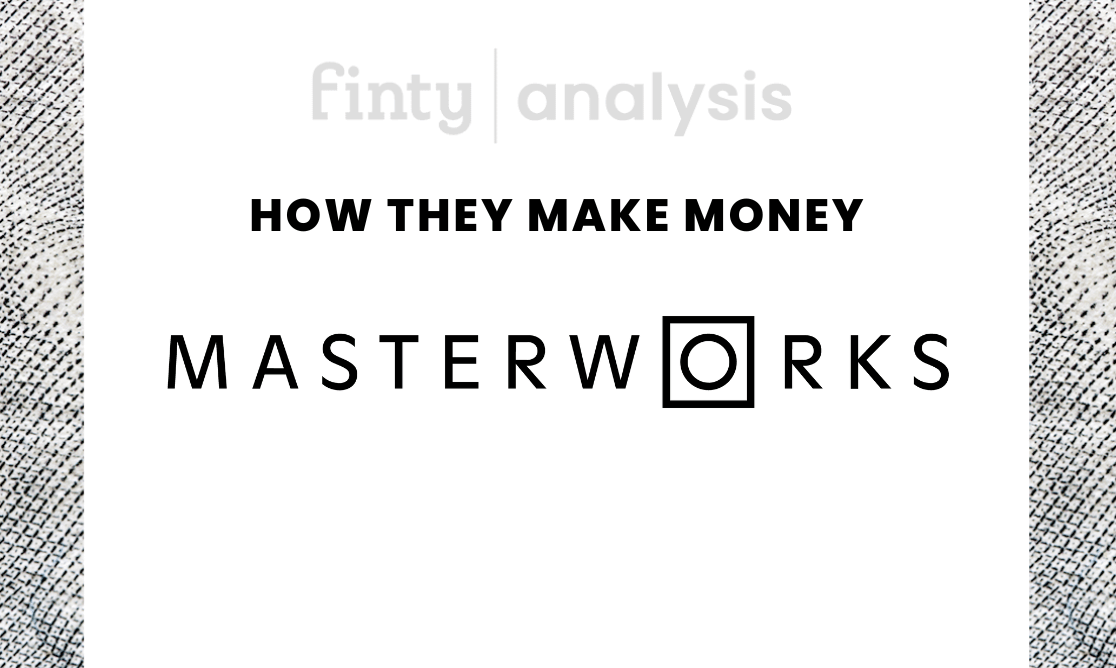Masterworks is an online art investment platform that allows everyday investors in America and beyond to own a slice of professionally curated, globally recognized masterpieces by famous artists such as Banksy, Pablo Picasso, Basquiat, and Andy Warhol.
This art asset class has traditionally been available only to billionaires and has been historically proven to hold its value over time.
Founded in 2017 by Scott Lynn, Masterworks is run out of New York City with a small team of 20+ employees. It raised over $15 million in funding from Winklevoss Capital and Fidelity Investments and became the first online art investment platform to go public through a SPAC in 2020.
So how does Masterworks make money?
How does Masterworks work?
Masterworks buys and maintains ownership of blue-chip art, allowing individuals to purchase shares in the underlying artwork.
The Masterworks business model has been praised for democratizing high-end art as an investment. Through its platform, investors can purchase shares starting at $20 and earn modest returns when the paintings sell.
Masterworks uses algorithms and data analysis to determine which art pieces to invest in and manage in its portfolio.
How Masterworks makes money
Masterworks makes money by selling fractional shares in investment art to investors, charging a commission on eventual sales, and charging storage and insurance fees.
Sales levy on fractional shares
Masterworks earns a price per share on every fractional share in a piece of art it sells on its platform.
After purchasing a piece of contemporary art, Masterworks registers it with the Securities and Exchange Commission (SEC) to enable it to sell fractional shares in the work to investors via its platform. This process ensures that the artworks are qualified investments, allowing Masterworks to accept retail and accredited investors.
Once the artwork is SEC-approved, Masterworks informs its members and allows them to purchase fractional shares at the listed price of $20 per share.
Storage and insurance fees
Masterworks charges a fee to the shareholders to store and insure the art it owns. It holds the works of art for three to ten years, only selling when they source qualified collectors. The company has sold several art pieces, with an average realized net return of 17.8%.
Management and commission fees
Masterworks charges two fees—a 1.5% annual management fee based on the total value of the shareholder’s account. There is no option to pay this fee in cash as they deduct this charge in equity each year, gradually reducing the number of shares owned.
Twenty percent of the profits from selling a work of art on the open market after three to ten years goes to Masterworks to run the business, make a tidy profit, pay storage, conduct appraisals, and pay insurance on these valuable works of art. SEC regulatory fees don’t come cheap, either.
However, Masterworks does not charge transaction fees. You won’t owe anything for buying the shares initially or for selling them to another investor on the secondary market.
What part of Masterworks is most profitable?
The 20% sale commission to the end user is the most significant source of revenue for Masterworks. It generates revenue every time a piece of art is sold on its platform through a primary offering or secondary market sales. The sale of fractional shares to high-net-worth investors, storage fees, and insurance fees contribute to the company’s overall profitability.
Future growth engine
Masterworks is well-positioned for growth in the future as the art investment market continues to grow globally. The company is also considering expanding its offerings to include more types of art investments, such as limited-edition prints and sculptures. Additionally, Masterworks is exploring international markets to diversify its portfolio and increase its customer base.
Risks
- Market fluctuations: The art market can be volatile, and the value of the pieces in Masterworks’ portfolio may fluctuate.
- Competition: Masterworks faces competition from other players in the art investment market, including traditional art investment firms and new players entering the space.
- Regulatory risk: The art investment market is heavily regulated, and Masterworks must comply with these regulations to remain operational.
Competitors
- Artsy. Artsy is a leading online art marketplace that allows users to buy, sell, and learn about art. It offers a wide range of works from both established and emerging artists.
- Mearto. Mearto is an online art appraisal and auction platform that offers services for buying and selling art. It provides expert appraisals and offers a range of artworks for sale, including paintings, sculptures, and photographs.
- Arthena. Arthena is a data-driven investment platform for art that allows users to invest in professionally curated artwork portfolios. It offers a range of art investment options, including index funds and private investment portfolios.
- Art Agent. Art Agent is a modern art advisory firm that provides clients access to the best contemporary art worldwide. It offers services such as art research, acquisition, and management.
- Invaluable. Invaluable is an online auction platform offering various art, antiques, and collectibles. It provides a seamless bidding experience and access to leading auction houses and galleries worldwide.


